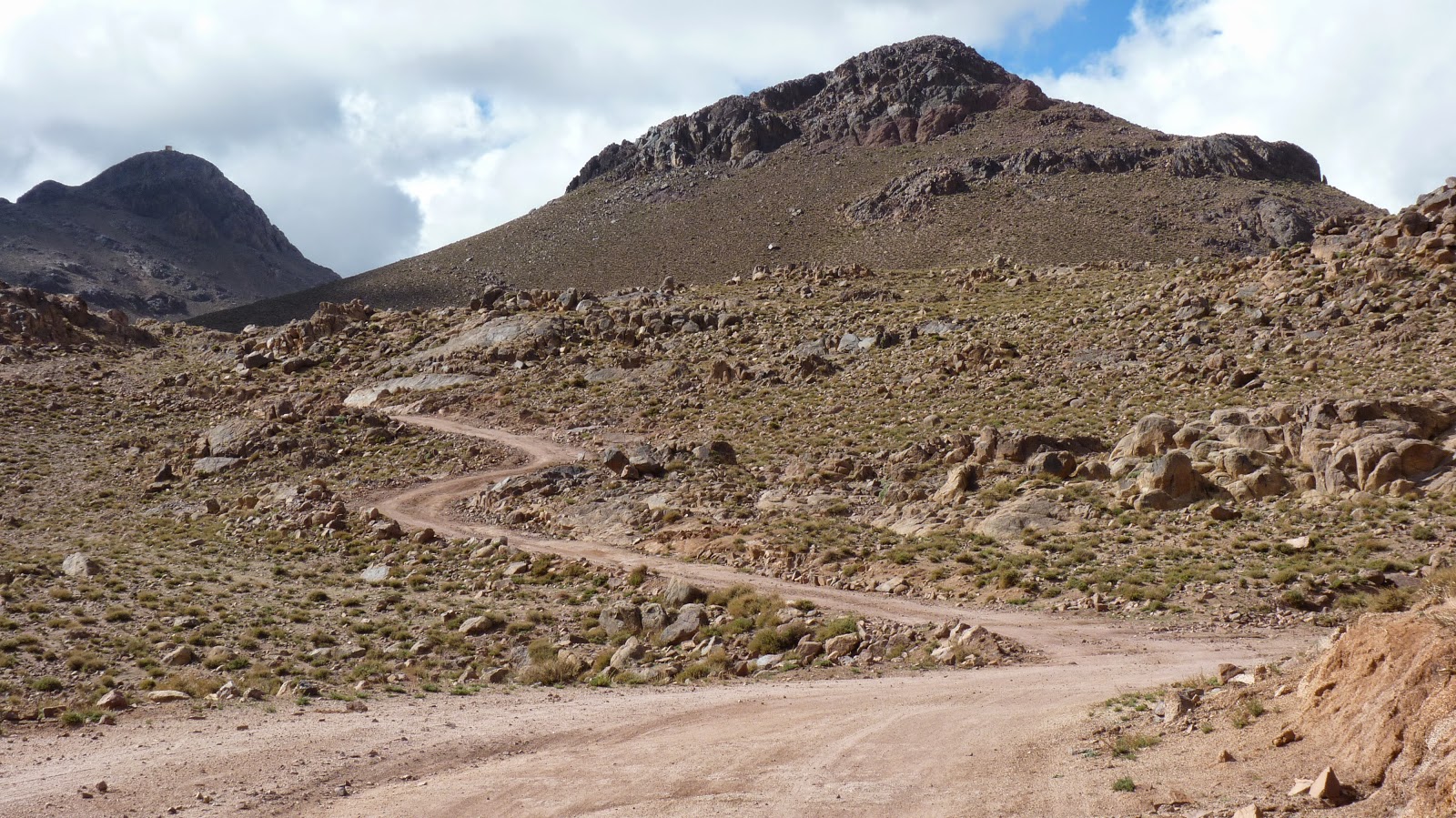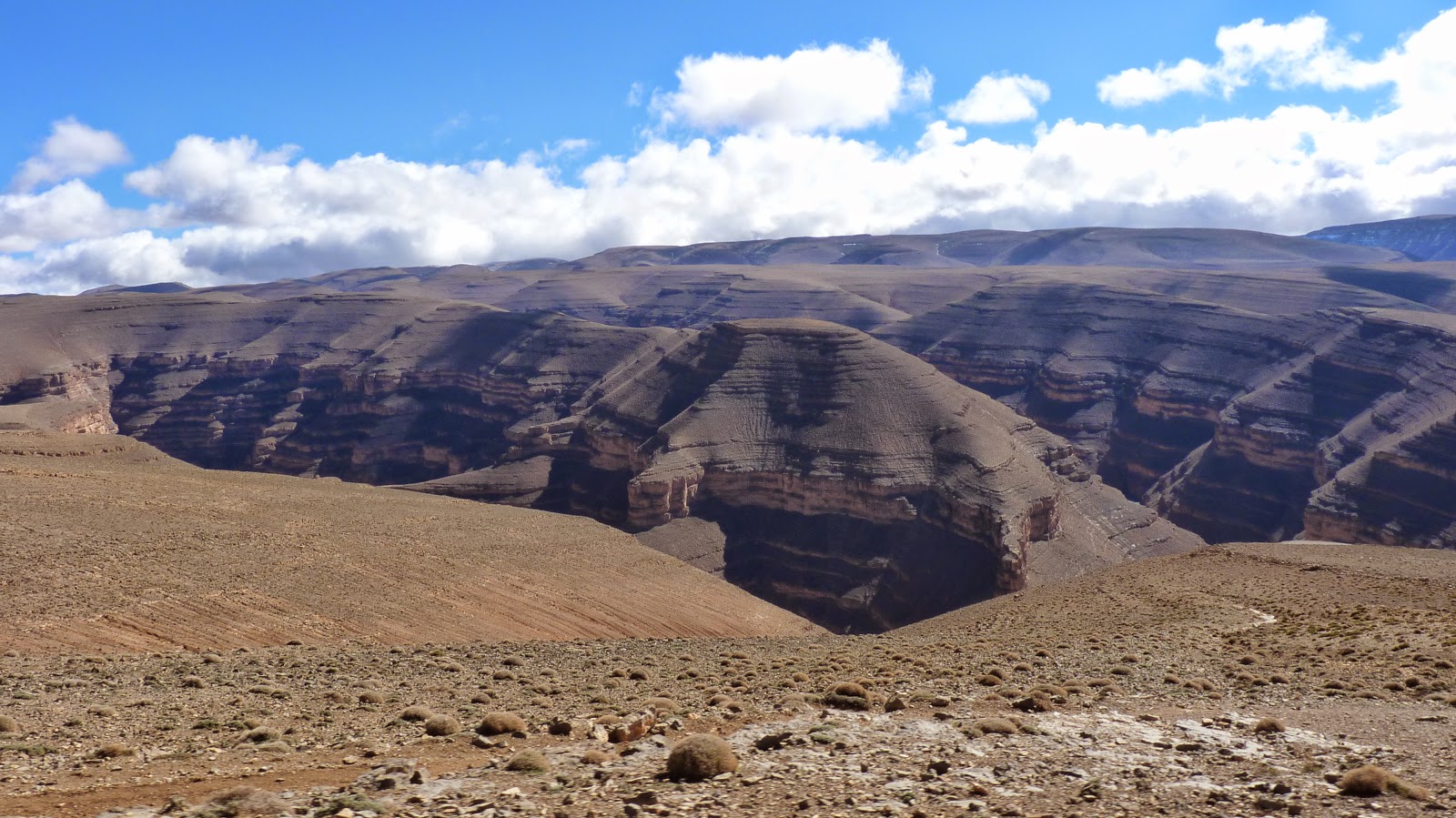We took two days to follow a route over the high Atlas mountains
taken from a book named ‘Morocco Overland’, written by seasoned Morocco
expert Chris Scott. The route uses a
mix of off-road tracks and regular paved roads and took us to just over 2,900
metres at its highest point. To our surprise the on-road
sections turned out to be tougher going than the off-road sections. This was mainly higher up in the mountains,
where heavy rains had caused major flooding that deposited mud and rocks over the
roads. There were some fairly swift fords to cross and in one valley we tried to take the road up we found the road
completely swept away. It was
impassable, but after some backtracking we found a better road going up an adjacent valley.
Day 1
Not far out of the town of Midelt, situated on the north side of the Atlas mountains, the route begins.
Winding into the low hills at the foot of the mountains
Despite the arid terrain there are still shepherds out here
tending flocks of sheep and goats. Doesn't exactly look like rich pickings for the sheep below.
Winding down into a bowl shaped valley known as the Cirque de Jaffar
Many poor people live here, seemingly in the middle of nowhere. The photo below shows a still inhabited flat roofed dwelling typical of this area.

As we drove through this area we were spotted or heard as we approached and could see local people (adults) running from their homes (huts) trying to get to the track in time to stop us. Occasionally we stopped, but mostly we tried to avoid people as in the poorest and most remote areas they invariably wanted something (money or clothes). Sometimes I would speed up to get past before they could reach the track, or if they reached the track and were waving us down I would pretend they were just waving and I would give a wave back as we drove past, much to their dismay. I realise this may sound a bit mean, but it should be understood that if we stopped for everyone trying to wave us down it would take a week or more to do this route rather than two days. And we aren't carrying surplus clothing or money to meet these peoples needs. We are carrying some basic items like lollies and pens that we give away, but that's about it. The book by Chris Scott also warns that some people will try to deceive foreigners such as ourselves, by arriving at the side of the track carrying empty water jugs to illustrate they are thirsty and there is no water. But the reality is the people living in these areas (even in the desert) know where to fill their water jugs and know the location of the numerous water wells. I'm pleased I did my research thoroughly before coming to Morocco, else it would be difficult to drive past someone claiming to be dying of thirst in the middle of remote arid surroundings with no roads nearby.
Our lunch stop
Resuming our journey
Note the satellite dish.
A bridge just wide enough to fit on
There are no more photos from day one as we continued after
dark, partly due to being delayed taking the road up a valley that turned out to
be washed out. Eventually we made
our way to a popular mountain village called Imichil. I say popular because it is situated along a
section of road where the two main routes over the mountains converge for a few
kilometres, hence it is a busier section of road. Imilchil had many auberges and riads (like
hotels) to offer and we picked the one shown in the photos below.
400 dirhams (about $55NZD) covered our room, a full dinner and a
Moroccan breakfast. This place proved a
great choice. The host didn’t speak much
English but was very welcoming.

The Moroccan dinner our host provided was excellent.
The food is really quite basic, but the spices they use turn ordinary
chicken into something quite amazing.
The auberge was also strangely cosy, despite it being cold outside
given we were above 2,000 metres and our bedroom having no heater. The only form of heating the entire building
had was the large drum shaped wood/coal burner shown in the photo below. But it really put out some heat. I also noticed that when our host went off to
cook our dinner he removed the tray at the bottom, full of glowing coals, and took it out to the kitchen - I gather this is how our
dinner was cooked.
Day 2
A typical Moroccan breakfast



Getting packed and ready to get back on the route again.
The main street in Imilchil.
Staying on the road for a few kilometres we passed through several villages.
The open terrain means children hear or see
us coming before we enter their village.
And invariably they are there waiting for us. I had read about this when researching
Morocco and so we have been carrying supplies of lollies to hand out to
children. But it’s not quite what I
expected. Can you see the near agony/desperation on
this girl’s face?
Some of the kids snatch at the lollies and are a bit
desperate and aggressive. It also gets
overwhelming at times - even if you're not planning to stop hoards of children see you coming from a distance and you can see them running down from the village towards you. If you
stop to give a lollie to a small number of children the whole car is suddenly
surrounded by a couple of dozen.
Moreover I’m aware it is debatable whether handing out lollies to these
children is good practice. Many of the
adults here see us as cash cows and I wonder if giving lollies to children is
embedding this view of foreigners as a source of money and goods at an early
age. As a result we are changing our approach to this and are are now becoming much more selective
about when, who and how and even if we give away lollies.


There are many poor
people here, but what tends to happen is that anyone you come across out here
will ask for something. For instance
while I was stopped to deflate tyres some people moving their livestock, who
looked well dressed and in no particular need of anything, still came over to
see what they could get. In Chris
Scott’s book he refers to such people as ‘chancers’ and notes that they’ll flag
you down for a ride even if they were walking the other way, or ask you for a
cigarette even if they don’t smoke (they can barter it later). But this is all part and parcel of learning
the culture of Morocco.
This was a friendly bloke, who was happy to have his photo
taken.
And back offroad again into marvellous surroundings. I think the photos through this part of the journey speak for themselves.
Heading up the track towards the pass at 2906 metres.
Views from the pass.
The vehicle tracks etched into the hillside below helps to better appreciate the scale.
A local bus that takes this route.
You can see the track etched into the hill on the far side.
Spying a nice spot down by a river to stop for lunch.
Finally we had opportunity to put the new mokka pot to use.
We keep the onboard water tank (43 litres) topped up whenever we come across a source of clean water. The water that flowed in this river looked good.
Doing the laundry the old fashioned way.
Back on a sealed road for the rest of the route down the Dades Gorge.
Our accommodation for the night; an auberge in the Dades Gorge.
The next morning we drove the rest of the way out of the Dades Gorge into the nearby town of Boumalne Dades to get fuel, food and commence our next route over the Jebel Sahro mountains, which is the topic of the next blog.






























































































































